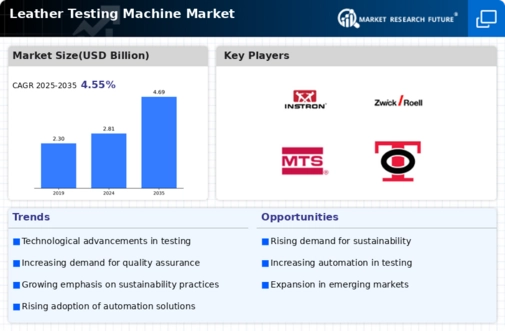Regulatory Compliance and Standards
The Leather Testing Machine Market is significantly influenced by stringent regulatory compliance and standards imposed by various governing bodies. These regulations mandate that leather products meet specific safety and quality benchmarks, which necessitates the use of sophisticated testing machines. For instance, the European Union has established comprehensive guidelines for leather goods, compelling manufacturers to invest in testing equipment that can accurately assess parameters such as durability, chemical resistance, and environmental impact. This regulatory landscape is expected to propel the leather testing machine market, as companies strive to adhere to these standards while maintaining competitiveness in the marketplace.
Rising Demand for Quality Assurance
The Leather Testing Machine Market is experiencing a notable increase in demand for quality assurance across various sectors, particularly in the fashion and automotive industries. As consumers become more discerning regarding the quality of leather products, manufacturers are compelled to adopt rigorous testing protocols to ensure compliance with international standards. This trend is reflected in the projected growth of the leather testing machine market, which is anticipated to reach a valuation of approximately USD 300 million by 2026. The emphasis on quality assurance not only enhances brand reputation but also mitigates the risk of product recalls, thereby driving the adoption of advanced testing machinery.
Sustainability and Eco-Friendly Practices
The Leather Testing Machine Market is increasingly influenced by the growing emphasis on sustainability and eco-friendly practices within the leather sector. As consumers become more environmentally conscious, manufacturers are under pressure to adopt sustainable production methods, which often require rigorous testing of materials and processes. This shift towards sustainability is driving the demand for testing machines that can evaluate the environmental impact of leather products, including chemical usage and waste management. Consequently, the leather testing machine market is likely to benefit from this trend, as companies invest in equipment that aligns with eco-friendly initiatives and meets consumer expectations.
Technological Advancements in Testing Equipment
The Leather Testing Machine Market is witnessing a surge in technological advancements that enhance the efficiency and accuracy of testing processes. Innovations such as automated testing systems and real-time data analytics are becoming increasingly prevalent, allowing manufacturers to streamline operations and reduce time-to-market. The integration of artificial intelligence and machine learning into testing machines is also emerging, enabling predictive maintenance and improved testing outcomes. As these technologies evolve, they are likely to attract investment and drive growth within the leather testing machine market, with estimates suggesting a compound annual growth rate of over 5% in the coming years.
Growing Leather Industry and Export Opportunities
The Leather Testing Machine Market is closely tied to the growth of the leather industry, which continues to expand due to rising consumer demand for leather goods. Countries with established leather production capabilities are increasingly focusing on enhancing their export potential, necessitating the use of advanced testing machines to meet international quality standards. For example, nations such as India and Brazil are ramping up their leather exports, which in turn fuels the demand for reliable testing equipment. This trend is expected to bolster the leather testing machine market, as manufacturers seek to ensure their products are competitive in the global marketplace.


















Leave a Comment